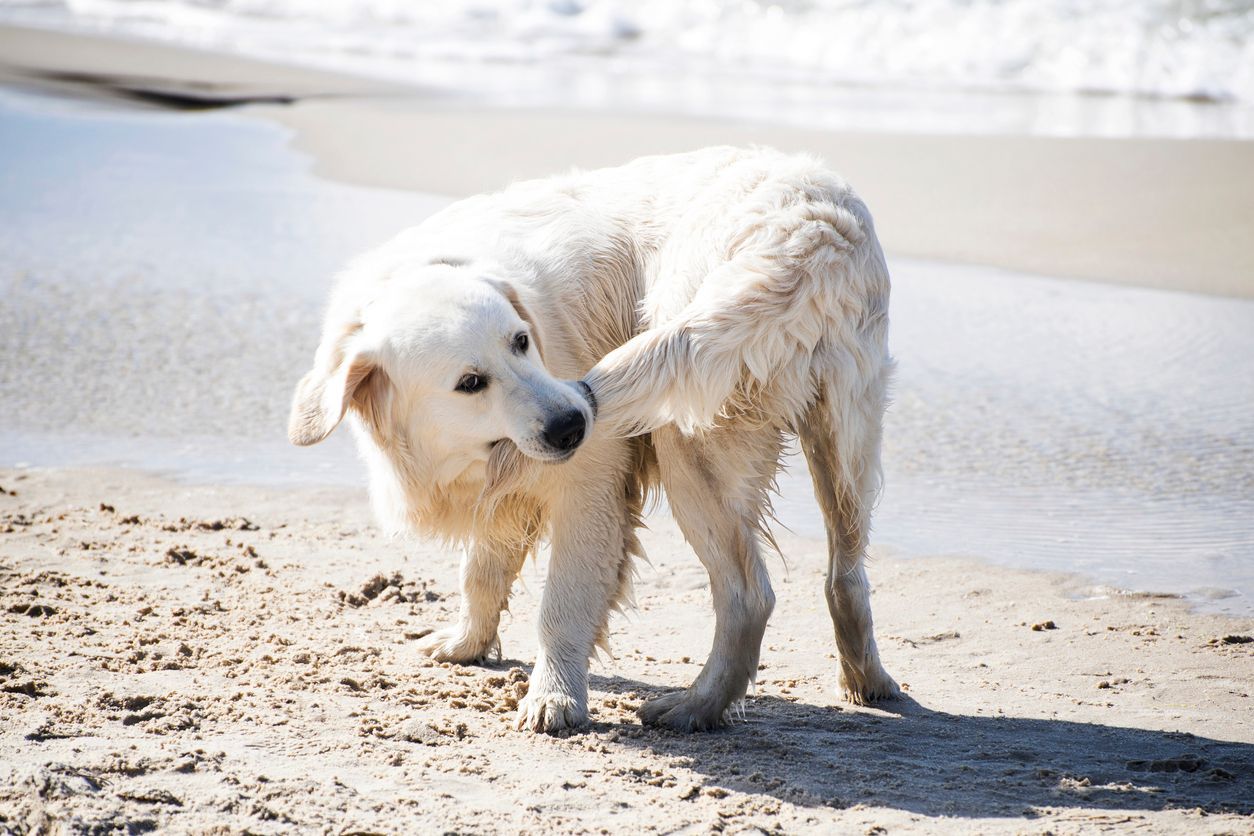Protecting your baby from fleabites

Most fleas are not dangerous, but they can potentially spread dangerous diseases. The best way to prevent a baby’s flea exposure is to keep all pets on vet-recommended flea prevention all year. Choosing the right flea preventative can be challenging, so working with a veterinarian is best to ensure your choice is safe for your pets and children in the home. If you have pets and children, read on to learn:
- How flea infestations can affect babies
- How babies are exposed to fleas and how to limit exposure
- The safety of pet flea prevention around babies
Adult fleas usually stay on animal hosts but can bite children who are nearby, and have the potential to spread disease. Veterinarians can offer guidance on safe and effective flea prevention for pets in the home to limit a baby’s exposure. Talk to your health-care provider if a baby has been exposed to fleas, shows signs of infection, or has itchy bites.
Can fleas hurt babies?
Most fleabites in children and pets are not harmful. However, fleas can potentially spread dangerous diseases or carry tapeworms that can infect children. If a pet has fleas, the home has fleas, too, which means children and babies in the home are also exposed to fleas. Fleas get into carpets, bedding, upholstered furniture, and soft toys. You can protect your pet and the humans around them by keeping them on safe, effective flea prevention year-round.
Flea-borne disease
The pathogens that cause flea-borne illnesses can be transmitted when an infected flea bites a host or when flea dirt gets into a scratch or wound on the skin. Right after emerging from their cocoons, new adult fleas start looking for an animal host but can bite humans, including babies, until they find a more suitable furry pet to infest. Adult fleas that live on an animal are unlikely to leave, but it is possible for them to bite a baby in close contact with the infested pet.
“Flea dirt is widespread throughout an infested animal’s environment, so it’s easy to be exposed to it, especially for people who spend a lot of time on the carpet, bedding, or furniture where pets like to spend their time,” explains Dr. Jo Myers, a vet on Vetster. “Crawling babies can easily be exposed to flea dirt and newly emerging adult fleas, even if they are never in the same room as the infested pet.”
Flea-borne diseases that can affect both pets and people include:
- Plague
- Flea typhus (murine typhus)
- Cat scratch disease (bartonellosis)
While our current understanding of flea-borne illnesses is that they are uncommon in the United States, they can be a concern for both animal and human health. Flea-borne diseases are easily preventable with year-round flea prevention for pets in the household.
Tapeworms
Tapeworms that most commonly affect humans are not the same species as those that are carried by cat fleas and infect dogs and cats. Most human cases of tapeworms occur due to eating raw or undercooked meat or fish contaminated with tapeworms. Even though humans are not the intended host for tapeworm species carried by fleas, it’s still possible for a person to be infected if they accidentally ingest an adult flea carrying tapeworm eggs and larvae. Adult fleas spend most of their time on a pet, so they’re much more likely to be consumed by the animal rather than by people, but it is still possible.
What you should know about fleas
Understanding how fleas breed and reproduce can help you better understand how to prevent them and protect your children. The flea life cycle has four stages: eggs, larvae, pupae, and adults. Adult fleas live primarily on the skin and in the fur of animal hosts where they feed on blood meals, mate, and lay eggs. Flea dirt (or flea droppings) accumulates on the skin of infested pets. Flea feces appear grainy and dark, similar to black pepper or dark sand. Flea dirt mostly contains digested blood, so it turns a rusty red color when smeared on a damp paper towel.
Flea eggs aren’t sticky, so they fall off pets and into the environment, which could be your home. Eggs have a better chance of surviving and hatching on soft or protected substrates such as carpets and upholstery. Larvae feed on flea dirt, pet dander, and other organic debris before spinning a cocoon and becoming pupae. Pupae do not eat or move around and are very protected in their cocoons. When the conditions are right, new adult fleas hatch from the cocoons and search for a new host. A flea can stay in the pupae phase for months.
Flea populations grow very quickly, so by the time adult fleas or flea dirt are seen on a pet, the pet’s environment is usually already heavily contaminated with eggs, larvae, pupae, and flea dirt. Adult fleas only make up about five percent of the flea population. The only exception to this is the brief moment in time when a previously flea-free pet picks up a few adult fleas from a contaminated environment outside of the home. If the pet is not on flea control, these few fleas can quickly start a flea infestation.
Cat fleas, the most common flea species on pets, are opportunistic feeders and will bite humans nearby even though they cannot survive for long on human skin or hair. Human fleas exist, but they are a different species than those that affect pets and are very rare in the United States.
How to prevent a baby’s contact with fleas
The best way to prevent fleas is to keep all at-risk pets in the home on vet-recommended flea prevention year-round. Without animal hosts, fleas won’t be able to establish a large population in the home because they breed on pets. This limits a baby’s contact with fleas.
Always use flea products exactly as instructed to ensure their safety and efficacy. Pay close attention to safety warnings on topical flea products and environmental sprays. Some are unsafe to use around children, and some topical products intended for dogs are highly toxic for cats even if they are not applied directly to the cat. Do not split doses between animals; always use the right dosage based on your pet’s species, weight, and age.
Choosing the best flea product to protect your pets from fleas can be challenging. There are numerous types of flea prevention available as prescriptions or over the counter. Many products available over the counter do not work and can be dangerous for pets. Even normally effective products may not be safe or effective if used incorrectly. Talk to a veterinary professional to learn the best flea-prevention option for your pets and family.
Is my pet’s flea treatment safe to use around my baby?
Year-round flea prevention for dogs and cats is the best way to limit a baby’s exposure to fleas, and it is generally very safe around children when the products are chosen wisely and used as instructed. Avoid direct skin contact with topical flea preventatives during application and let the product dry before allowing children to have contact with the pet. It can cause problems if a child gets a wet product on their skin and ingests it. Flea collars may also be toxic if a child touches them and puts their hands in their mouth. Always keep flea treatments locked up and out of reach of pets and children. Oral flea medications do not appear to cause serious illness when accidentally ingested by humans, but it’s still best to keep them out of the hands of children. It’s important to watch your pet closely when giving oral flea medications to be sure you know if your pet throws it up or spits it out.
Talk to a veterinarian about safe products to use on pets, in the home, and in the yard if you have children or multiple pet species. Talk to your health-care provider if your baby has been exposed to fleas. When used as directed and kept out of reach of children, flea prevention helps keep your baby safe by preventing contact with fleas that can transmit diseases or cause other health problems. Online vets are available through the Vetster platform to offer advice on flea prevention, and some may be able to offer prescriptions for safe flea-control products.*
*Online vets can prescribe medications or therapeutic diets for your pet if your state or province permits a veterinarian–client–patient relationship (VCPR) to be established remotely. Please note that vets are not obligated to write a prescription; this is done at their sole discretion. Controlled substances cannot be prescribed via telemedicine under any circumstances.
FAQ - Protecting your baby from fleabites
Will fleas harm my baby?
Most fleabites on babies are harmless other than causing temporary itchy skin. However, fleas can potentially spread infectious diseases and tapeworms to babies in close contact with them.
How can I keep fleas away from my baby?
Giving all pets flea prevention is the best way to prevent a baby’s flea exposure. If you are faced with a flea infestation in your home, try to keep your baby away from infested areas such as carpets, pet bedding, and upholstered furniture. Hardwood floors and other easily cleaned smooth surfaces are less likely to harbor flea eggs, larvae, and pupae. Attempt to keep pets out of these clean areas so you have separate spaces in the house for pets and your baby.
How do you get rid of fleas when you have a baby?
The key to getting rid of fleas when you have a baby is keeping the pets in the household on a safe, effective, vet-recommended flea-control product for at least three consecutive months. Always read the labels on flea-control products very carefully and follow them exactly. Talk to a veterinarian if you have more questions about flea treatments that are safe to use in households with children. Thoroughly cleaning and vacuuming the home can also help remove some fleas from the environment while the pets are being treated. Talk to a professional exterminator about home flea treatments that are safe to use around children.




